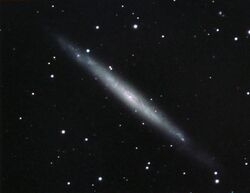Astronomy:Central massive object
 The star-like nucleus at the centre of this edge-on spiral galaxy, NGC 4244, is a central massive object. | |
A central massive object (CMO) is a high mass object or cluster of objects at the centre of a large star system, such as a galaxy or globular cluster. In the case of the former, the CMO may be a supermassive black hole, a nuclear star cluster, or even both together.[1]
The most massive galaxies are thought to always contain a supermassive black hole (SBH); these galaxies do not contain nuclear star clusters, and the CMO is identified with the SBH. Fainter galaxies usually contain a nuclear star cluster (NSC). In most of these galaxies, it is not known whether a supermassive black hole is present, and the CMO is identified with the NSC.[2] A few galaxies, for instance the Milky Way and NGC 4395, are known to contain both a SBH and a NSC.[3]
Although this is suggestive that all galaxies have CMOs, and that a common mechanism of galaxy formation causes both, ESA MIRI scientist Torsten Böker observes that some galaxies appear to have neither SBHs nor NSCs.[4]
The mass associated with CMOs is roughly 0.1–0.3% times the total mass of the galactic bulge.[2]
See also
- Core collapse (cluster)
- Galactic Center
- Stellar dynamics
References
- ↑ Böker 2010a, p. 61.
- ↑ 2.0 2.1 Merritt, David (2013). Dynamics and Evolution of Galactic Nuclei. Princeton, NJ: Princeton University Press. https://openlibrary.org/works/OL16802359W/Dynamics_and_Evolution_of_Galactic_Nuclei.
- ↑ Nishiyama, S.; Schödel, R. (2012). "Young, Massive Star Candidates Detected throughout the Nuclear Star Cluster of the Milky Way". Astronomy & Astrophysics 549: A57. doi:10.1051/0004-6361/201219773. Bibcode: 2012yCat..35490057N.
- ↑ Böker 2010b, p. 103.
Bibliography
- de Grijs, Richard; Lépine, Jacques R. D., eds (2010a). "Nuclear star clusters". Star Clusters (IAU S266): Basic Galactic Building Blocks Throughout Time and Space. IAU symposium and colloquium proceedings. 266. Cambridge University Press. ISBN 9780521764995.
- Macchetto, F. Duccio, ed (2010b). "Young Massive Star Clusters in the Era of the Hubble Space Telescope". The Impact of HST on European Astronomy. Astrophysics and Space Science Proceedings. Springer Science & Business Media. ISBN 9789048134007.
 |

